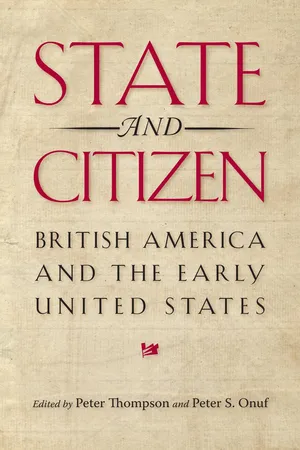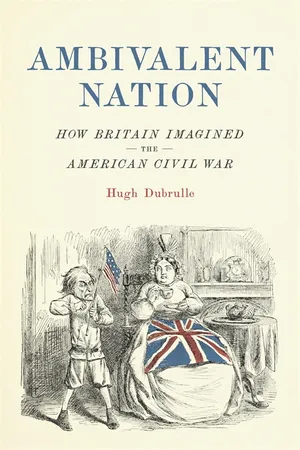History
Confederate States of America
The Confederate States of America was a collection of 11 Southern states that seceded from the United States in 1860-1861, leading to the American Civil War. The Confederacy aimed to preserve the institution of slavery and maintain states' rights. The Civil War ended in 1865 with the defeat of the Confederacy and the reintegration of the Southern states into the Union.
Written by Perlego with AI-assistance
Related key terms
2 Key excerpts on "Confederate States of America"
- eBook - ePub
State and Citizen
British America and the Early United States
- Peter Thompson, Peter S. Onuf(Authors)
- 2013(Publication Date)
- University of Virginia Press(Publisher)
TATE , NATION, AND CITIZEN IN THE CONFEDERATE CRUCIBLE OF WARPAUL QUIGLEY
ANY EVALUATION OF state formation in the Confederacy takes shape in the shadows of two towering, controlling facts. First, the fact that the Confederacy lost the Civil War and expired in 1865. When scholars think about state formation during the Civil War, they habitually do so with reference to the victorious Union, not the vanquished Confederacy. This predisposition tends to obscure a robust process of state and national development that took place in the Confederacy during the war years, making it difficult to see the Confederacy as an integral part of—rather than a glaring exception to—the long-term transformations involving state and citizen that the current volume explores. The second all-important fact is that white Southerners justified their withdrawal from the Union in the language of states’ rights, a language that became even more prominent after 1865 as a retrospective explanation for secession. The common assumption that Southerners were somehow naturally committed to states’ rights while Northerners instinctively supported federal power has clouded recognition of the accumulation and exercise of political power in the Confederacy’s national government. In fact, antebellum Southern politicians had been considerably less averse to the principle of central power than to the actual or potential exercise of it in ways that they deemed against their interests—especially the particular interest of slavery. Recognizing as much makes the extent of Confederate state formation seem much less surprising.1For most twentieth-century scholars, Confederate state formation was an oxymoron. Frank L. Owsley and David Donald, for example, offered explanations for the South’s defeat grounded in states’ rights, localism, and an antipathy toward centralized power. In the 1970s Emory M. Thomas advanced a strong counterargument in two important works that presented radical transformation as the central theme of Confederate history. The pressures of modern war, according to Thomas, drove white Southerners toward a series of interlocking changes in culture, society, economic life, and politics that resulted in the replacement of the “Old South” with a quite different “Confederate South.” These changes included shifts in the social status of women, slaves, and poor white people, for example, but most pertinently here they also involved a massive expansion of central governmental authority that redefined the relationship between state, nation, and citizen.2 - eBook - ePub
Ambivalent Nation
How Britain Imagined the American Civil War
- Hugh Dubrulle(Author)
- 2018(Publication Date)
- LSU Press(Publisher)
75 Third, the enormous sacrifices that southerners made during a protracted war to protect their new state indicated a high level of commitment to their national community.Paul Quigley has recently pointed out that in 1861 “southern nationalists demanded international acceptance of an independence they claimed to have already achieved.” To obtain this acceptance, in fact, to attain legitimacy, southern leaders realized they had to erect a stable, functioning government.76 While they failed to obtain formal recognition from the British government, they did succeed in convincing most of the British public that they had indeed created a working state. In October 1861, Lord Lyons, the British minister in Washington, D.C., reported that the Confederate state was “obeyed without question and exercises all the functions of Government with the most perfect regularity.”77 The British press agreed. To take one example, in the wake of McClellan’s failure to take Richmond in 1862, the Standard asserted that the Confederate government “has maintained order and enforced law with remarkable vigour and success. It has a perfect organization and it received from its subjects a cordial and thorough-going support. . . . The thorough loyalty of the people is shown by the thorough confidence reposed in them by the Administration.”78 In his November 7, 1862, memorandum concerning recognition of the Confederacy, Sir George Cornewall Lewis accepted that the existence of a Confederate state that “received the general obedience of the Southern population” was “indisputable.”79 For a pro-southern propagandist like Spence, this argument was the biggest arrow in his quiver. The Confederacy’s character and origins, he argued, did not matter. As he put it, Britons “have no more right to inquire why it [the Confederacy] has come into existence than to question of a man what right he had to be born.”80 All that did matter was that the southern states formed “a distinct community, and have over them a government approved by themselves, and reasonably executing the functions of administration.”81 Indeed, the existence of such a government proved that the southerners were a “separate people.”82
Learn about this page
Index pages curate the most relevant extracts from our library of academic textbooks. They’ve been created using an in-house natural language model (NLM), each adding context and meaning to key research topics.

